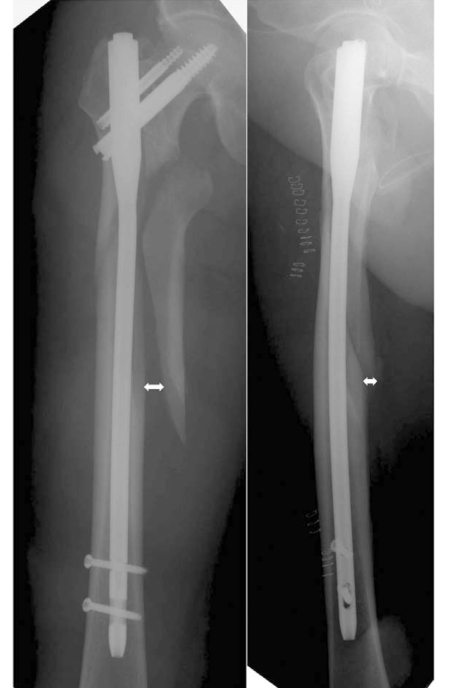Clinical Results of Femoral Subtrochanteric Fractures
- Affiliations
-
- 1Department of Orthopedic Surgery, Asan Medical Center, College of Medicine, University of Ulsan, Seoul, Korea. jjkim2@amc.seoul.kr
- 2Department of Orthopedic Surgery, Haeundae Paik Hospital, College of Medicine, Inje University, Busan, Korea.
- KMID: 1461174
- DOI: http://doi.org/10.5371/jkhs.2010.22.3.222
Abstract
- PURPOSE
This study examined the clinical course of subtrochanteric fractures of the femur as well as the risk factors of complications.
MATERIALS AND METHODS
A retrospective study was performed on 56 patients with femoral subtrochanteric fractures who were treated at our hospital from 2004 to 2008. Risk factors, such as the type of fracture, type of implant, soft tissue dissection at the fracture site, communition of the medial cortex and degree of fracture displacement after the reduction, were compared to determine their effect on the rate of complications, such as nonunion and implant failure. Open reduction with a soft tissue dissection at the fracture site was performed in 34 cases, and a closed reduction was performed in 22 cases. Thirty five cases had medial cortex communition and 21 cases did not.
RESULTS
There were 8 cases of nonunion(14.3%). There was a positive correlation between the degree of fracture displacement after the reduction and the union time (P=0.017). The union time was longer when there was communition of the medial cortex. A subtrochanteric fracture using an open reduction tended to have a long union time but this was not statistically significant. There was no correlation between the type of implant and union time.
CONCLUSION
The union time is longer in subtrochanteric fractures with communition of the medial cortex. Therefore, it is important to preserve the blood supply at the fracture site using a closed reduction and restore the fracture reduction accurately.
Figure
Cited by 4 articles
-
The Character of Reverse Obliquity Intertrochanteric Fractures in Elderly Patients
Ji Wan Kim, Jae-Suk Chang, Jung Hwan Sung, Jung Jae Kim
J Korean Fract Soc. 2013;26(3):173-177. doi: 10.12671/jkfs.2013.26.3.173.Factors Affecting Time to Bony Union of Femoral Subtrochanteric Fractures Treated with Intramedullary Devices
Jung-Yoon Choi, Yerl-Bo Sung, Jin-Hee Yoo, Sung-Jae Chung
Hip Pelvis. 2014;26(2):107-114. doi: 10.5371/hp.2014.26.2.107.Clinical Results of Complex Subtrochanteric Femoral Fractures with Long Cephalomedullary Hip Nail
Kwang-kyoun Kim, Yougun Won, Danica H. Smith, Gi-Soo Lee, Hee Young Lee
Hip Pelvis. 2017;29(2):113-119. doi: 10.5371/hp.2017.29.2.113.Treatment of Femur Subtrochanteric Fracture Using the Intramedullary Long Nail; Comparison of Closed Reduction and Minimal Open Reduction
Sang Joon Lee, Sang Hong Lee, Sang Soo Park, Hyung Seok Park
J Korean Orthop Assoc. 2015;50(1):18-24. doi: 10.4055/jkoa.2015.50.1.18.
Reference
-
1. Nungu KS, Olerud C, Rehnberg L. Treatment of subtrochanteric fractures with the AO dynamic condylar screw. Injury. 1993. 24:90–92.
Article2. Rohilla R, Singh R, Magu NK, Siwach RC, Sangwan SS. Mini-incision dynamic condylar screw fixation for comminuted subtrochanteric hip fractures. J Orthop Surg (Hong Kong). 2008. 16:150–155.
Article3. Bergman GD, Winquist RA, Mayo KA, Hansen ST Jr. Subtrochanteric fracture of the femur. Fixation using the Zickel nail. J Bone Joint Surg Am. 1987. 69:1032–1040.4. Kinast C, Bolhofner BR, Mast JW, Ganz R. Subtrochanteric fractures of the femur. Results of treatment with the 95 degrees condylar blade-plate. Clin Orthop Relat Res. 1989. 238:122–130.5. Kyle RF, Cabanela ME, Russell TA, et al. Fractures of the proximal part of the femur. Instr Course Lect. 1995. 44:227–253.
Article6. Siebenrock KA, Muller U, Ganz R. Indirect reduction with a condylar blade plate for osteosynthesis of subtrochanteric femoral fractures. Injury. 1998. 29:Suppl. C7–C15.
Article7. Parker MJ, Dutta BK, Sivaji C, Pryor GA. Subtrochanteric fractures of the femur. Injury. 1997. 28:91–95.
Article8. Sims SH. Subtrochanteric femur fractures. Orthop Clin North Am. 2002. 33:113–126. vii.9. Vanderschot P, Vanderspeeten K, Verheyen L, Broos P. A review on 161 subtrochanteric fractures--risk factors influencing outcome: age, fracture pattern and fracture level. Unfallchirurg. 1995. 98:265–271.10. Asher MA, Tippett JW, Rockwood CA, Zilber S. Compression fixation of subtrochanteric fractures. Clin Orthop Relat Res. 1976. 117:202–208.
Article11. Trafton PG. Subtrochanteric-intertrochanteric femoral fractures. Orthop Clin North Am. 1987. 18:59–71.
Article12. Ramakrishnan M, Prasad SS, Parkinson RW, Kaye JC. Management of subtrochanteric femoral fractures and metastases using long proximal femoral nail. Injury. 2004. 35:184–190.
Article13. Curtis MJ, Jinnah RH, Wilson V, Cunningham BW. Proximal femoral fractures: a biomechanical study to compare intramedullary and extramedullary fixation. Injury. 1994. 25:99–104.
Article
- Full Text Links
- Actions
-
Cited
- CITED
-
- Close
- Share
- Similar articles
-
- Epidemiology and Clinical Features of Atypical Femoral Fractures
- Subtrochanteric Fracture after Cannulatd Screw Fixation of Femoral Neck Fracture in a Child: A Case Report
- Surgical Treatment of Subtrochanteric Fracture of Femur with Spiral Blade Unreamed Intramedullary Femoral Nail
- Subtrochanteric Fracture: Emphasis on Surgical Techniques in Nailing
- Subtrochanteric Femur Fracture after Multiple Drilling for Treatment of Nontraumatic Osteonecrosis of the Femoral Head: A Case Report



